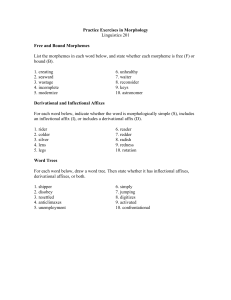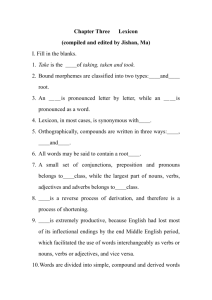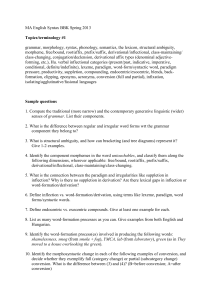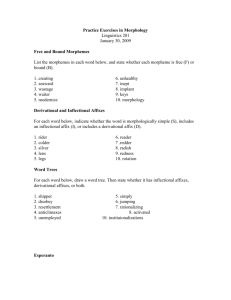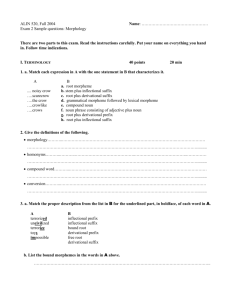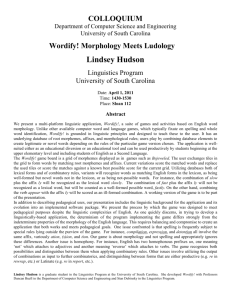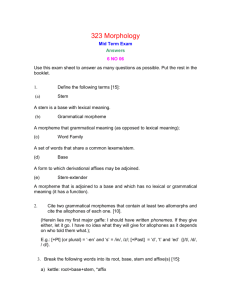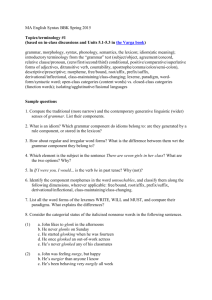here - Université d'Ottawa
advertisement
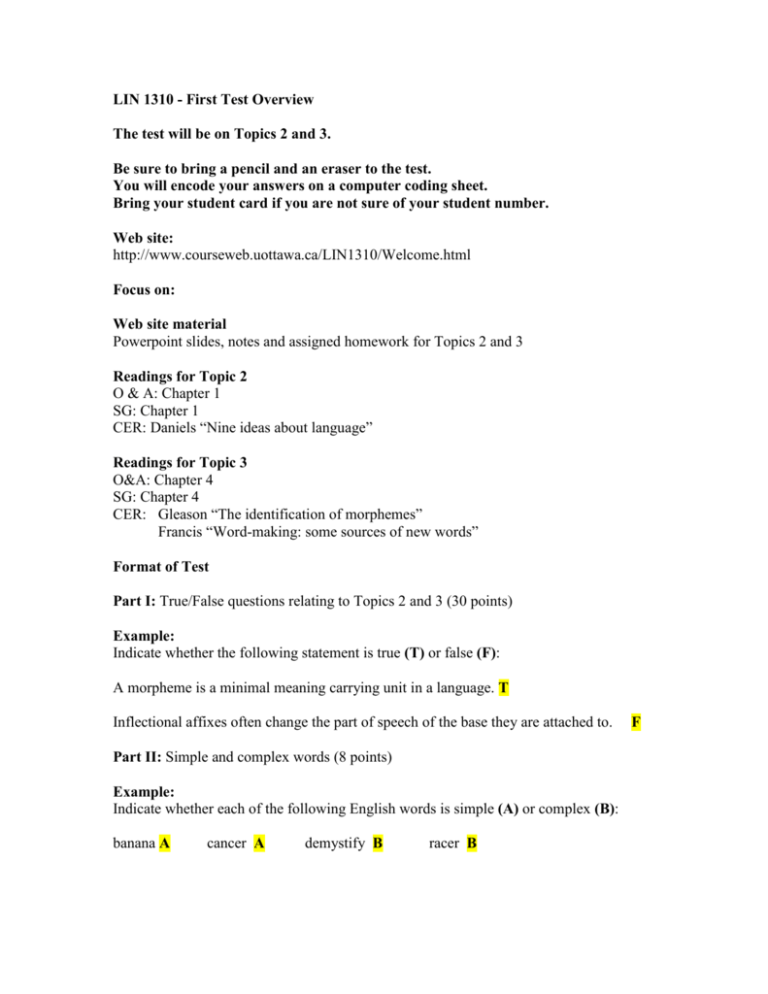
LIN 1310 - First Test Overview The test will be on Topics 2 and 3. Be sure to bring a pencil and an eraser to the test. You will encode your answers on a computer coding sheet. Bring your student card if you are not sure of your student number. Web site: http://www.courseweb.uottawa.ca/LIN1310/Welcome.html Focus on: Web site material Powerpoint slides, notes and assigned homework for Topics 2 and 3 Readings for Topic 2 O & A: Chapter 1 SG: Chapter 1 CER: Daniels “Nine ideas about language” Readings for Topic 3 O&A: Chapter 4 SG: Chapter 4 CER: Gleason “The identification of morphemes” Francis “Word-making: some sources of new words” Format of Test Part I: True/False questions relating to Topics 2 and 3 (30 points) Example: Indicate whether the following statement is true (T) or false (F): A morpheme is a minimal meaning carrying unit in a language. T Inflectional affixes often change the part of speech of the base they are attached to. Part II: Simple and complex words (8 points) Example: Indicate whether each of the following English words is simple (A) or complex (B): banana A cancer A demystify B racer B F Part III: Endocentric and exocentric compounds (8 points) Example: Indicate whether each of the following English compounds (shown in bold) is endocentric (A) or exocentric (B) People who like that rock group are usually airheads. B Throwing a football accurately takes lots of practice. A Part IV: Identifying affixes (8 points) Example: In each of the following sentences, there is an underlined and bolded sequence of letters. Indicate whether the sequence is: A. a derivational affix B. an inflectional affix C. a base D. an infix E. none of these They walked all the way to school. B His main interest is botany. E The passengers deplaned in an orderly fashion. A Part V: Processes for word creation (6 points) Example: Select the process involved in the creation of the following words. was (from “be”) A. conversion B. suppletion C. internal change B. back formation C. clipping D. infixing pea (from “pease”) A. conversion D. acronym Part VI: Descriptivism versus prescriptivism (10 points) Example: Indicate whether each of the following statements is: A. prescriptivist or B. descriptivist. Uneducated people do not possess grammatical competence in their native language. A The sentence “He don’t got none” contains a double negative. B Part VII: Derivational and Inflectional Affixes (10 points) Example: Indicate whether each of the following statements applies to: A. derivational affixes B. inflectional affixes C. both derivational and inflectional affixes D. neither derivational nor inflectional affixes They are free morphemes. D They can change the part of speech of the bases they attach to. A Part VIII: Words trees (including compounds) (8 points) Example: Choose the tree that best illustrates the derivation of the following words: Rereading A. B. C. V V V V V Af Af V re read ing Af V Af Af V reread ing re reading re V V Af read ing Part IX: Morphology problem with 4 multiple choice questions worth 3 points each. (12 points) Example: Below is a body of data adapted from Ganada, an East African language. Answer the questions about Ganada which follow the data. Indicate the correct answer by filling in the space with the appropriate letter (A, B, C or D) on your computer coding sheet. In Ganada, the morpheme for singular on nouns is: A. aba B. omu C. kaxi D. lenzi In Ganada, the morpheme for plural on nouns is: A. aba B. omu C. kaxi D. lenzi In Ganada, the order of morphemes for number attached to nouns is: A. base + affix B. affix + base C. affix + base + affix D. base + affix + affix
